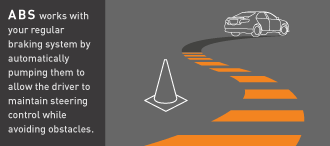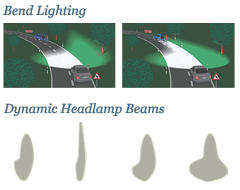Braking Systems
Antilock Braking Systems (ABS) detect the first signs of wheel lock under braking and interrupt the brake force for a fraction of a second at a time to allow the tyres to maintain grip. The main advantage of ABS is that it allows the driver to maintain steering control during wet braking, but it can also improve braking performance under low friction conditions (like a wet road) by allowing the braking force to remain at the maximum possible, just below the point at which a skid would start.

ABS is now widely specified on passenger cars (in the EU it is fitted to all cars, and in the USA it is standard on over 80% of cars and available as an option on the rest) and on Trucks.When ABS operates it’s important that the driver maintains pressure on the brake pedal and does not back off until the vehicle has slowed down as much as necessary.This US government website provides useful advice about using ABS:
> Learn more at NHTSA’s page on ABS
Emergency Brake AssistEmergency Brake Assist (EBA) also known as Brake Assist System (BAS) includes a range of electronic systems which detect a sudden application of the brakes in an emergency and automatically increase the brake force to the maximum allowed by the ABS.
View the Emergency Braking Assist Usage Graph
These systems mimic, or even improve on, the performance of an expert driver, by maximum braking faster than most drivers can do without assistance, and braking harder than many are able to do.
View the Braking Distances With and Without Brake Assist Graph
Stability Control
Electronic Stability Controls
Electronic Stability Programme (ESP) or Electronic Stability Control (ESC) is a further development of ABS, with additional sensors which detect any difference between the driver’s control input and the vehicle’s response. If it detects a difference, the system immediately intervenes, applying the brakes to individual wheels as necessary to correct the vehicle’s path. This helps to reduce over-steer and under-steer and thus improves vehicle stability, especially during severe cornering and on low-friction road surfaces.

Some systems include a connection to the engine management system, so that they can also reduce engine torque when required.
Lighting Technologies
Lighting and light signalling
Developments in lighting systems as well as vehicle-based computer systems have opened the possibility of much more flexible and effective headlight systems with such features as:
Bend Lighting where the headlamp beam reacts to steering wheel movement to see around the bend
Cornering Lights where additional light is provided in the direction of a sharp turn of corner,
Dynamic Headlamp beams where the shape of the beam can be altered automatically depending on conditions, such as weather conditions, restricted visibility, or for highway and urban driving

